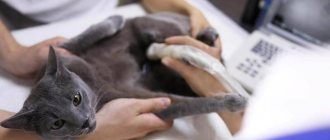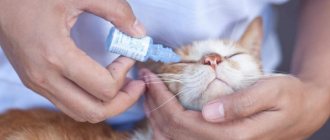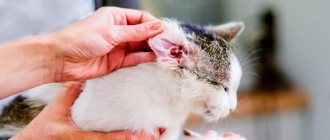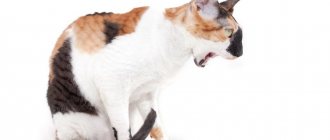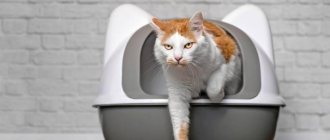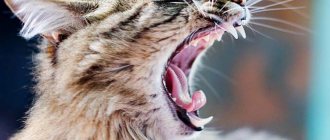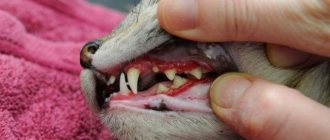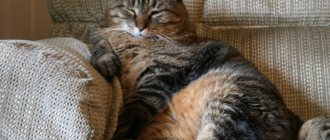In cats and kittens, it can be difficult to differentiate between vomiting/vomiting, regurgitation, and coughing. They are all very different and have different possible causes, so it is important to try to differentiate between them.
Vomiting is the active expulsion of contents from the cat's stomach and small intestine through the mouth. Vomiting is different from regurgitation, which is a passive movement that does not require force to expel contents through the cat's mouth.
You may also mistake it for a cough if you don't notice anything coming out. It is best to take a video if possible and show it to your veterinarian. He can help you determine if it is actually vomiting, and if so, why your cat is vomiting.
Here is some useful information about the causes of cat vomiting and possible treatments.
- Why does my cat feel sick and vomit? Questions could be:
- Gastrointestinal causes of vomiting in cats
- Causes of vomiting in cats not related to the gastrointestinal tract
- Bile/yellow
- Your cat is vomiting and won't eat.
- Can I give my cat anything at home to stop vomiting?
- Treatment of acute vomiting in cats
- Intestinal obstruction in cats
A cat regurgitates food: normal or pathological
Regurgitation of food is normal, but vomiting is pathological. Regurgitation occurs once or twice a day and not every day. The vomited material consists of food fragments or a white foamy mass. In this case, the pet is monitored and managed without the help of a veterinarian.
If attacks of vomiting occur 3 or more times a day or are repeated daily, this is a pathology that requires specialist intervention.
What to do if your cat is coughing
Any attentive owner can independently determine the nature of a cat’s cough and even its type. But understanding the reason for what is happening, much less taking a set of measures necessary to heal your pet, alas, will not work at home. This will require a personal examination by a specialist, additional diagnostic tests and equipment that is only available in the clinic.
It is important to understand: a cat’s cough is by no means an independent disease, but only a symptom, “a manifestation of one of a hundred diseases,” as old veterinarians liked to say. You need to look for the cause and eliminate it - and not try to cure the cough itself.
Is it possible to help an animal yourself?
At home, you can only alleviate the cat's condition before visiting a veterinarian. The air in the room where the animal is located should be fresh and humid - ventilate the room, but under no circumstances leave a sick pet in a draft, this will only worsen the problem. Inhalation of steam, which should not be too hot, can bring relief to a cat - this procedure is available at home even without any special equipment.
Try to calm your pet as much as possible. Cats are very sensitive and emotional, sudden attacks can frighten them, causing the cough to intensify and the situation as a whole to worsen. Caress a confused animal - it trusts you and should feel that a loving owner will take care of it.
It is necessary to take a coughing pet to the doctor as soon as possible, because he will only be able to receive real help after a qualified diagnosis. It is also important not to give your cat any medications before visiting the clinic . Firstly, the effect of the drugs will “blur” the symptoms of the disease and complicate the diagnosis. Secondly, cough is not a harmless problem at all; only an experienced specialist has the right to prescribe medications for its treatment, and only if he has clearly determined the reasons for the manifestation of this symptom.
Medical assistance
Provided a clear diagnosis is made and the exact cause of the cough is determined, the doctor can use many modern tools to treat it. But the starting point of any successful healing was and remains an accurate and timely diagnosis.
Table: treatment prescribed for different types of cough
| Cause of cough | General therapy | Drugs |
| Heartworm |
|
|
| Cat flu and other infections |
|
|
| Bronchial asthma |
|
|
| Worm infestations |
|
|
| Traumatic cough |
|
|
| Polyps and tumors |
|
|
Video: treatment of cough in cats
Antitussives
It is strictly prohibited to use antitussive or expectorant drugs independently, without a doctor’s prescription. The wrong choice or inaccurate dosage of the drug may not cure the cat, but, on the contrary, worsen its condition - leading to complications of the disease and dangerous side effects.
But we hope that information about what antitussive drugs are will be useful for every owner. These drugs, according to the nature of their action, are divided into two large subgroups: blocking and expectorant. There are also medications that combine both of these qualities and have a complex effect - these are mainly human medications, and not all of them will benefit a cat.
“Harmless” cough syrups for children (as well as adults) are absolutely not suitable for cats. These pharmacy delicacies are not always useful for people, given the high content of sugar, flavorings, dyes and other improvers. There is definitely no need to give such medications to cats. Products that contain alcohol or codeine are also not suitable for them.
Blocking drugs are good because they quickly relieve the animal from painful and painful coughing attacks. But such medications do not treat its cause, but simply “turn off” the cough center, blocking its functions. The cough is thus masked as a symptom, but the disease is not treated and the situation worsens. Such drugs can only be prescribed as a component of complex therapy, but not on their own.
Expectorant antitussive drugs have proven themselves well in the treatment of coughs of an infectious nature. By liquefying thick mucus and facilitating its elimination, such medications help not only to make the animal’s breathing easier, but also to clear its respiratory tract of pathogenic microflora - bacteria and viruses that have become the causative agents of the disease.
Table: veterinary cough medications for cats
| Drug name | Release form | Action | Approximate price |
| Divopride | Cough tablets for dogs and cats |
| 120 rubles per pack of 50 tablets |
| VetExpert VeTussin | Cough syrup for dogs and cats |
| 100 rubles per bottle of 100 milliliters |
| ZooHealth | Cough tablets for dogs and cats |
| 60 rubles per pack of 20 tablets |
| Helvet Lobelon | Homeopathic antitussive drug for the treatment of respiratory diseases, solution for injection |
| 350 rubles per bottle of 10 milliliters |
Medicinal herbs and cough preparations
Treating a cat’s cough with folk methods and herbs at one’s own discretion, and not on the doctor’s recommendations, can cause no less harm than drug self-medication - it is easy to transfer the disease to a critical stage, but sometimes it is simply impossible to reverse it.
You cannot indiscriminately recommend remedies from a natural pharmacy to treat a cat’s cough - even when using the safest of them, you should largely rely on the experience and advice of a veterinarian you trust. If the doctor does not mind, the natural preparations listed below can be used for kittens and pregnant cats, using them both internally and in the form of inhalations.
Licorice root decoction
An ancient herbal remedy for soothing coughs and removing phlegm. Effective, hypoallergenic.
Ingredients:
- crushed licorice roots - 1 heaped tablespoon;
- purified water - 1 glass.
Dried licorice root must be finely chopped before use.
Application:
- Medicinal raw materials are poured with cold water in the evening and left to infuse until the morning.
- Over low heat, bring the mixture to a boil under the lid.
- Reduce the heat to low and boil the broth for 12–15 minutes.
- Cool and filter.
- Adult animals are given an incomplete teaspoon of decoction three to four times a day, without combining with meals.
Infusion of coltsfoot leaves
One of the most famous medicinal plants with a strong expectorant effect.
Ingredients:
- dry or fresh coltsfoot herb - 1.5–2 teaspoons;
- boiling water - 1 cup.
For infusions, the entire aerial part of the coltsfoot is used, but most often the leaves
Application:
- Rub the medicinal raw material a little in your palms and pour it into a thick-walled (preferably ceramic) bowl.
- Pour freshly boiled water over the prepared coltsfoot, cover tightly with a lid and leave in a warm place for 30–40 minutes.
- Filter the finished infusion and pour into a clean container.
- Give to a sick cat three times a day to improve expectoration, warming the infusion before each dose.
Infusion of plantain leaves
An excellent healing and anti-inflammatory natural remedy; removes phlegm well and promotes tissue regeneration.
Ingredients:
- freshly picked plantain leaves - 1-2 pieces;
- hot water - 0.5 liters.
Whenever possible, use plantain leaves fresh rather than dried.
Application:
- Wash the plantain leaves thoroughly with running water and let them dry.
- Tear the leaves into small pieces - it is better not to use scissors or metal knives for chopping.
- The crushed raw materials can be slightly ground with a pestle in a non-metallic mortar.
- Pour well-mashed plantain leaves with boiled water not hotter than 70 degrees, seal tightly and wrap.
- After complete cooling, strain the infusion.
- Give the cat a teaspoon four to five times a day until complete recovery.
Medicinal plants can provide many benefits if used correctly
Also among the effective natural cough remedies are the following medicinal plants:
- wild rosemary;
- eucalyptus;
- oregano;
- anise fruit;
- birch and pine buds;
- linden flowers;
- elecampane;
- tricolor violet;
- lungwort;
- thyme, etc.
Herbal medicinal raw materials for the treatment of cough in cats are no less effective and safer than many medications, even those made on a natural basis. But the main problem with the use of such drugs in veterinary medicine remains the unpredictability of the animal’s response to a particular plant, especially as part of preparations.
Veterinarians report a large number of allergic reactions that occur in cats during such treatment. Need I say how dangerous this is - for example, in the case when coughing is a symptom of bronchial asthma? Obviously, when choosing useful plants in nature for self-medication, animals are fully guided by instincts and do not make fatal mistakes. And our inept care can too often harm them.
The cat often burps: reasons
Regurgitation in cats is normal and occurs for the following reasons:
- Regurgitation of semi-digested food by a lactating cat occurs in order to accustom kittens to solid food.
- Toxicosis of pregnancy: occurs after two decades of gestation, when other signs have not yet appeared.
- Gluttony: wild ancestors did not have a successful hunt every day. Therefore, the animals ate for future use. But, too much food is worse than not enough. The same thing happens if the owners try to give dry food according to the norm. Or there are competitors in the apartment. The animal attacks the pellets and eats too quickly. He doesn’t have time to drink anything, dry food absorbs moisture from the gastric mucosa. The body expels dangerous food to prevent dehydration.
- Residual effects of drugs. If the animal is fed after surgery, it will vomit.
- Hungry vomiting occurs in the morning, when an animal that is accustomed to eating by the hour forgot to feed it on time. A white foamy mass appears.
- Motion sickness in transport after feeding. Pieces of food shake and irritate the walls of the stomach.
- Hairballs that a long-haired pet swallows while licking can mix with food, form trichobezoars and block the intestinal lumen. To prevent this from happening, the cat begins to cough, vomit and regurgitate dangerous lumps.
- Soured or moldy food. With improper or prolonged feeding, peroxides are formed, which the body perceives as poisons and tries to get rid of them in every possible way. An opened bag of dry food can be stored for 40 days, and a can in the refrigerator can be stored for 36 hours.
- An excess of cereals or bread with a lack of meat and vegetables is perceived by the body as spoiled food.
- Foreign object: if it comes out, vomiting stops. Otherwise, urgent veterinary attention is required.
Be sure to read:
What to do if the kitten cannot poop, how can you tell if the cat is constipated?
Vomiting, its causes and dangers
Vomiting is a complex protective process based on reflexes, with the help of which the cat’s body gets rid of dangerous and harmful substances. Vomiting is usually the main symptom of gastrointestinal problems.
Let us immediately note that an attack of vomiting, occurring once every 3-4 days, is the norm, especially in cats. However, there are still specific reasons. To understand them, you need to analyze the cat’s diet, and perhaps make it starve for a while. Most often, cats vomit from overeating - they simply eat too much and too quickly. This applies to both dry food and natural food, but dry pieces are very easy to regurgitate, especially if they are poorly chewed. Most often, those animals that regurgitate are those that live in conditions of competition for food and therefore absorb food quickly and greedily. By the way, some of them will not disdain to eat the food removed from the body again.
Animals that live together tend to eat quickly and chew their food poorly, so regurgitation is common for them.
If a domestic cat often regurgitates food as soon as it leaves its bowl, then it is overeating or this type of food is of poor quality. Economy-class food, such as Felix, Whiskas, Sheba and the like, have a poor composition and contain many harmful additives, so such food will clearly not benefit your pet.
It is advisable to purchase premium and super-premium food for your pet, and for chronic diseases - specialized lines of such food
Causes of vomiting in cats
The main causes of vomiting can be divided into two large groups: reflex irritation of the digestive organs and poisoning.
In the first case, foreign substances or excessive amounts of food irritate the organs of the digestive tract and cause a reflex reaction of rejection. The following reasons may lead to this:
- improper diet: too rich, not suitable for cats, poor consistency (sticky, rubbery food, with bones, etc.);
- ingestion of a large amount of hair when licking (especially in long-haired cats): hairballs cause mechanical irritation of the stomach and also interfere with the normal excretion of feces from the body, which also contributes to vomiting;
- parasites that mechanically irritate the liver and intestines;
- chronic diseases of the gastrointestinal tract;
- ingestion of foreign bodies - small toys, hair bands, threads, waste from a garbage can;
- seasickness - vomiting due to disturbances in the functioning of the vestibular apparatus.
In the second case, poisoning occurs with toxic substances that enter the blood, spread throughout the body, irritate the vomiting center in the brain and cause vomiting. Intoxication may have the following origins:
- waste products of intestinal parasites - kittens are especially sensitive to their effects;
- poor quality, expired food;
- chemicals: detergents, bleach, medications, indoor plants;
- infectious and inflammatory diseases leading to disorders of the gastrointestinal tract;
- chronic kidney diseases, causing general intoxication of the body;
- false pregnancy, which can occur in cats after estrus;
- brain damage: trauma, edema, increased intracranial pressure;
- stress, shock or psychological trauma.
Danger of vomiting
A dangerous consequence of vomiting is dehydration, which quickly occurs with persistent and prolonged vomiting. It is especially poorly tolerated by small kittens. An animal can quickly die from dehydration, so if vomiting does not stop, you should immediately take the animal to a doctor.
With persistent vomiting, even water is not retained in the cat’s body: as soon as the cat drinks, it starts vomiting again
It is also necessary to measure the cat’s temperature: in case of infectious and inflammatory diseases it increases, in case of poisoning and shock it decreases. In both cases, you need to go to the doctor or call him at home.
The temperature in cats is measured in the anus for 2-3 minutes, the norm is a temperature of 38 to 39 degrees
The vomit should not contain blood, mucus, have a strange color or a foul odor - in this case, you should also contact your veterinarian immediately.
Types of vomiting in cats and symptoms
Pathological vomiting is almost always colored. The expelled masses should be inspected for the presence of worms, foreign objects, and pay attention to the color.
In this way, a preliminary diagnosis can be made. Responsible felinologists keep a diary in which they record everything that happens to the pet. The records will provide an invaluable service to the veterinarian in making a final diagnosis and prescribing treatment.
The following colors of pathological vomiting are distinguished:
- Bright yellow: indicates intestinal contents have entered the stomach. It occurs as a symptom of dangerous diseases - panleukopenia, helminthic infestation, liver pathologies, inflammation of the gallbladder.
- Green indicates food poisoning or a bacterial infection due to a viral infection. Green vomit also occurs with gallbladder diseases. A large amount of bile enters the stomach and is oxidized.
- Scarlet: bleeding has occurred in the pharynx or esophagus due to injury from a foreign object.
- Brown or brown - an ulcer has formed in the stomach or intestines and is bleeding. Under the influence of hydrochloric acid, the blood becomes brown in color.
- Black-brown with a fecal odor. Occurs when the intestines are blocked by trichobezoars or helminths. Requires veterinarian intervention and laboratory tests.
Should I call the vet if my cat is vomiting?
You should call your veterinarian immediately if:
- Your cat vomits more than two or three times in a row.
- Your cat has other symptoms, such as refusal to eat and diarrhea. If your cat also has diarrhea, it will be difficult to keep him hydrated without seeing a veterinarian.
- Your cat has not eaten or drunk for 12 hours and has vomited several times in a row.
- Your cat has already been diagnosed with a medical condition (such as diabetes, kidney disease, and hyperthyroidism). This is an emergency and your cat should be seen immediately as this may indicate that her illness is progressing. These patients require early medical intervention as they can become dehydrated very quickly.
- Your cat vomited a worm. You need to deworm your cat and other pets as soon as possible. It is also important to keep the environment clean and empty litter boxes several times a day to prevent your pets from becoming reinfected.
Can I give my cat anything at home to stop vomiting?
Unfortunately, there are not many over-the-counter medications that will help cats avoid vomiting. If your cat does start vomiting, do not give him anything by mouth (including water or food) for several hours.
When can I feed my cat again after he has vomited?
After waiting a few hours, you can try feeding your cat about 25% of what you normally feed to see if he can keep it down.
Then gradually increase the amount over the next 24 hours. If your cat starts vomiting again, you will need to seek help from your veterinarian.
A cat spits up after eating: what to do?
The cause of vomiting is the presence of food in the gastrointestinal tract. Therefore, to stop vomiting, you need to eliminate the cause - that is, food. The cat is not fed for half a day, or better yet, for a day. But you shouldn’t get carried away, because after a two-day fast, the mechanism for extracting energy from fat depots turns on. Reserve nutrients rush to the liver and a dangerous disease develops - lipidosis.
You must show your will and not react to your pet’s extortion; even a small crumb of food causes reflex vomiting. If the animal reacts to drinking, it is removed, a veterinarian is called, and before his arrival, a saline solution is injected subcutaneously in unlimited quantities.
Be sure to read:
Vomiting in a cat: causes, what different types of vomit indicate, first aid, treatment, when it is not dangerous
The next day, the pet is given some easily digestible food in an amount of no more than 1/3 of the norm. They give him plenty of water and monitor his behavior. If no new vomiting follows, increase the portion, bringing it to normal.
During diet therapy, the use of dry granules is suspended and wet nutrition is used. It is not necessary to use Smecta or Enterosgel, however, sorbents will help normalize digestion.
Causes and types of cough in cats
Cats cough just like people. But our pets have slightly different causes of cough and its mechanism itself. In most cases, in this way the animal reflexively protects itself by squeezing out small foreign bodies or sputum from the respiratory tract.
Many ignorant owners humanize their pets so much that they attribute to them the same diseases that humans suffer from. This common misconception has nothing to do with reality - respiratory infections that exist in people are not transmitted to cats, and they, in turn, are not able to infect the owner with their cat flu, for example.
How does a cat cough?
During coughing attacks, pets can frighten their owners, especially inexperienced ones. When coughing, many cats take a special, rather tense position: they bend, almost pressing themselves to the floor, and stretch their head forward. At the same time, loud wheezing often escapes from their throat, and the whole body shudders in convulsions, reminiscent of strong vomiting.
Instinctively, the cat takes the most comfortable position in order to clear its throat in the best possible way.
Externally, the picture is such that the simplest conclusion suggests itself: the cat choked on something. Having made such a “diagnosis”, the caring owner immediately begins to try to remove from the pet’s throat what, in his opinion, got there. In most cases, such emergency assistance is pointless and sometimes very harmful.
The fact is that coughing does not always indicate that the cat has choked on some object. But if this is indeed the case, without experience and special devices, removing a foreign body from a cat’s throat is very dangerous.
Why and how do cats cough? The cat’s medulla oblongata “controls” the cough—it is here that the cough center is located, to which the animal’s nervous system transmits special signals. These signals are received by special sensitive receptors localized in reflexogenic (cough) zones:
- around the vocal cords;
- on the walls of the larynx;
- at the border of the trachea and bronchi.
Attacks of painful coughing may be accompanied by gagging
When irritated by any factors, the receptors signal an alarm. Having received these messages, the cough center gives its command - and the cat coughs. In fact, it looks like sharp exhalations, during which the air is spontaneously expelled from the lungs in shocks, evacuating everything unnecessary and harmful from the respiratory tract along the way:
- foreign objects;
- sputum;
- pus and mucus.
When preparing for a visit to the clinic, try to determine the characteristics of your animal’s cough - what is its strength, volume and duration; how it changes in dynamics. These are very important observations; they will contribute to more accurate and faster diagnosis. Veterinarians differentiate cough in cats into the following types:
- by duration - acute (from a couple of days to several weeks) and chronic (lasts several months and even years);
- by strength - weak cough, strong, superficial, deep, hysterical and debilitating, sometimes accompanied by vomiting;
- by timbre - ringing or muffled;
- by the presence or absence of discharge and its nature: dry cough or wet cough with mucus, as well as purulent or bloody sputum;
- by manifestation - rare, frequent and constant, it also matters what time of day it appears;
- by season - this is basically how the allergic nature of a cough is determined.
Preventing regurgitation after eating in cats
To combat regurgitation, the following measures are taken:
- do not overfeed your pets, it is better to reduce portions and give them more often;
- prevent food spoilage: an opened bag of granules should be fed 40 days in advance, canned food 36 hours in advance when stored in the refrigerator;
- do not feed your pet less than 2 hours before traveling in a car;
- comb long-haired pets to minimize hair getting into the stomach when licking;
- To ensure that the hairs do not clump and come out with feces, use Malt paste or specialized super premium food.
How veterinarians treat vomiting in cats
It is important to distinguish between acute and chronic vomiting. Chronic vomiting is defined as a cat that vomits more than once a week or vomits the same thing then breaks for more than three months. This is very different from a cat who suddenly starts vomiting (acute).
Treatment of acute vomiting in cats
The first step in properly treating your cat for vomiting is to determine the underlying cause. First, your veterinarian will perform a non-invasive diagnosis.
This includes:
- Biochemical and complete blood count tests to screen for conditions such as kidney disease and diabetes.
- Stool examination to exclude parasites.
- Abdominal radiograph to rule out larger tumors or foreign bodies that may be causing obstruction.
If these tests are normal and your cat is acutely vomiting, your veterinarian will likely recommend supportive treatment with anti-nausea medications.
Cats that vomit hairballs can be put on a special high-fiber diet along with medications that will help ease the passage of the hairballs.
Treatment for a cat that is constantly vomiting (chronic vomiting in cats)
If your cat continues to vomit or has a history of chronic vomiting, further evaluation will be indicated as described below:
- Gastrointestinal panel: Tests pancreatic enzymes to rule out pancreatitis. He will also look at cobalamin and folic acid to determine if there are signs of malabsorption in the small intestine.
- Abdominal ultrasound: This imaging technique is very sensitive in detecting smaller foreign objects that are not visible to X-rays. This ultrasound examines the pancreas and helps measure the wall of the gastrointestinal tract. This will also help rule out any enlarged lymph nodes, which are sometimes seen with cancer.
- Chest X-ray: This may be recommended if it is unclear whether your cat is vomiting, regurgitating, or coughing. Chest X-rays are also recommended for older cats to rule out signs of cancer.
In some cases, the diagnosis returns to normal or does not provide a definitive diagnosis. This can be seen if the disease is at the cellular level of the small intestine.
In this case, the next step is to obtain a biopsy of your cat's gastrointestinal tract to differentiate between inflammatory bowel disease, food hypersensitivity, and gastrointestinal lymphoma.
Your veterinarian may try a new diet before taking a biopsy if it is due to a food allergy.
